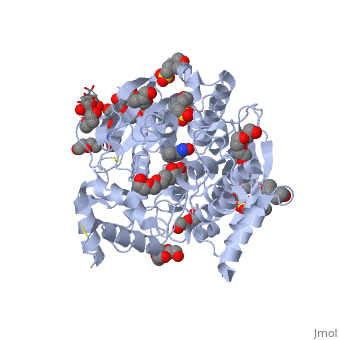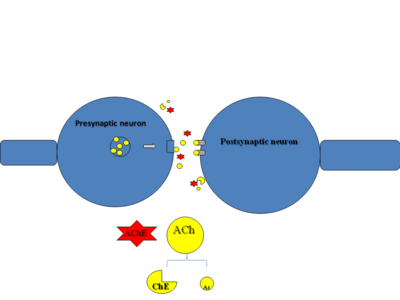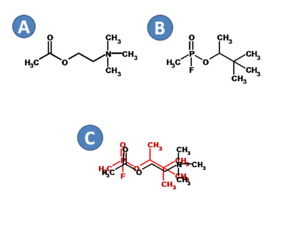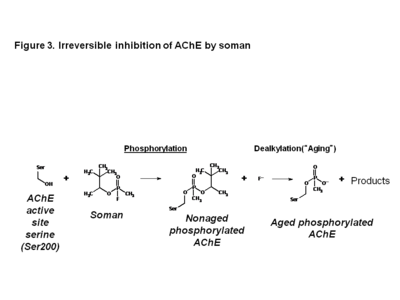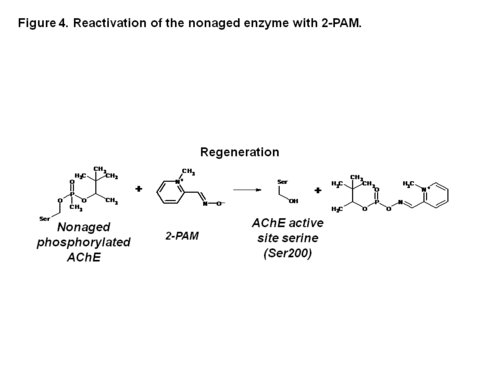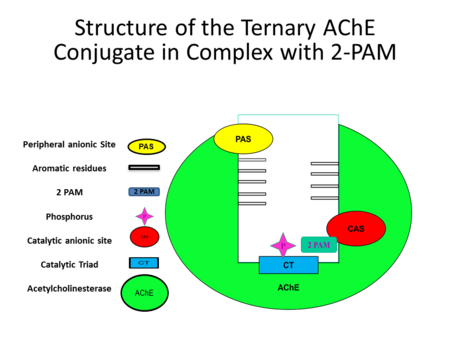Acetylcholinesterase inhibitors
From Proteopedia
(Difference between revisions)
| (39 intermediate revisions not shown.) | |||
| Line 1: | Line 1: | ||
<StructureSection load='2wg1' size='500' side='right' caption='Structure of AChE with Soman and 2 PAM (PDB entry [[2wg1]])' scene=''> | <StructureSection load='2wg1' size='500' side='right' caption='Structure of AChE with Soman and 2 PAM (PDB entry [[2wg1]])' scene=''> | ||
| - | '''Acetylcholinesterase (AChE)''' is an enzyme that catalyses the hydrolysis of the neurotransmitter acetylcholine (ACh) to acetate and choline, and plays a crucial role in terminating the nerve impulse at cholinergic synapses. Reversible inhibitors of AChE are used to treat diseases such as Alzheimer’s disease (AD) and Parkinson’s disease (PD). Conversely, irreversible inhibition of AChE by organophosphates (<scene name='Acetylcholinesterase_inhibitors/Phosphorus/3'>OP</scene>), such as soman, can lead to death. In this process, the OP covalently attaches to a <scene name='Acetylcholinesterase_inhibitors/Serine_residue/5'>serine residue</scene> in the active site to generate a <scene name='Acetylcholinesterase_inhibitors/Ser200_and_op/1'>phosphorylated enzyme</scene>. Subsequently, the OP is dealkylated, a process that is termed aging, generating a form of the enzyme that cannot be reactivated by antidotes, such as pralidoxime (2-PAM). Recently, the structures of Torpedo californica (Tc) AChE conjugated with soman, in both the non-aged and aged forms, and 2-PAM have been solved. From these structures, it is clear that a structural reorientation of His440, a component of the active site, occurs during the aging process. Additionally, the structure of the ternary complex of the aged AChE complex with <scene name='Acetylcholinesterase_inhibitors/2_pam/1'>2-PAM</scene>, revealed that the oxime functional group is not optimally positioned for nucleophilic attack on the phosphorous atom.<ref name=”practice”> PMID: 19642642</ref> | + | '''[[Acetylcholinesterase]] (AChE)''' is an enzyme that catalyses the hydrolysis of the neurotransmitter acetylcholine (ACh) to acetate and choline, and plays a crucial role in terminating the nerve impulse at cholinergic synapses. Reversible inhibitors of AChE are used to treat diseases such as Alzheimer’s disease (AD) and Parkinson’s disease (PD). Conversely, irreversible inhibition of AChE by organophosphates (<scene name='Acetylcholinesterase_inhibitors/Phosphorus/3'>OP</scene>), such as soman, can lead to death. In this process, the OP covalently attaches to a <scene name='Acetylcholinesterase_inhibitors/Serine_residue/5'>serine residue</scene> in the active site to generate a <scene name='Acetylcholinesterase_inhibitors/Ser200_and_op/1'>phosphorylated enzyme</scene>. Subsequently, the OP is dealkylated, a process that is termed aging, generating a form of the enzyme that cannot be reactivated by antidotes, such as pralidoxime (2-PAM). Recently, the structures of Torpedo californica (Tc) AChE conjugated with soman, in both the non-aged and aged forms, and 2-PAM have been solved. From these structures, it is clear that a structural reorientation of His440, a component of the active site, occurs during the aging process. Additionally, the structure of the ternary complex of the aged AChE complex with <scene name='Acetylcholinesterase_inhibitors/2_pam/1'>2-PAM</scene>, revealed that the oxime functional group is not optimally positioned for nucleophilic attack on the phosphorous atom.<ref name=”practice”> PMID: 19642642</ref> |
ACh is a neurotransmitter that is essential for nerve transmission at the cholinergic synapse (Figure 1). In the beginning a nerve impulse reaches the presynaptic membrane which acts upon vesicles that contain ACh. Then ACh is released into the synapse. Afterwards, ACh diffuses across the synapse where it binds and activates receptors on the postsynaptic neuron. As a result a nerve impulse is initiated. It is also important to terminate the impulse by breaking down ACh into acetyl and choline portions by AChE. | ACh is a neurotransmitter that is essential for nerve transmission at the cholinergic synapse (Figure 1). In the beginning a nerve impulse reaches the presynaptic membrane which acts upon vesicles that contain ACh. Then ACh is released into the synapse. Afterwards, ACh diffuses across the synapse where it binds and activates receptors on the postsynaptic neuron. As a result a nerve impulse is initiated. It is also important to terminate the impulse by breaking down ACh into acetyl and choline portions by AChE. | ||
[[Image:slide3.png|right|400px|thumb| [[Figure 1]]]] | [[Image:slide3.png|right|400px|thumb| [[Figure 1]]]] | ||
| - | + | AChE is a very fast enzyme<ref>PMID: 14501022</ref> and even though the active site is at the bottom of a deep (~20 Â) and narrow (~5 Â) gorge <ref>PMID: 18586019</ref>, it has several features that ensure rapid catalysis.<ref>PMID: 19642642</ref> | |
| - | AChE is a very fast enzyme and even though the active site is at the bottom of a deep (~20 Â) and narrow (~5 Â) gorge, it has several features that ensure rapid catalysis.<ref>PMID: 19642642</ref> | + | |
Primarily, | Primarily, | ||
| - | 1. 14 aromatic residues line the active site and filter ACh, by cation-π interactions, from the surface of AChE to the <scene name='Acetylcholinesterase_inhibitors/Catalytictriad/2'>catalytic triad</scene> (Ser200, Glu327 and His440).<ref>PMID: 19642642</ref> | + | 1. 14 aromatic residues line the active site <ref>PMID: 18502801</ref> and filter ACh, by cation-π interactions, from the surface of AChE to the <scene name='Acetylcholinesterase_inhibitors/Catalytictriad/2'>catalytic triad</scene> (Ser200, Glu327 and His440).<ref>PMID: 19642642</ref> |
2. AChE has a dipole that helps "attract" to the active site <ref>PMID: 19642642</ref> | 2. AChE has a dipole that helps "attract" to the active site <ref>PMID: 19642642</ref> | ||
'''Low levels of Acetylcholine''' | '''Low levels of Acetylcholine''' | ||
| - | Due to the decrease in levels of ACh found in patients with Alzheimer's Disease (AD) and Parkinson's disease (PD) there is a need to increase the amount of ACh available in the post-synaptic neuron. By reversibly inhibiting AChE it is possible to stop the breakdown of ACh and thereby increase its levels at the synapse. Therefore AChE is the target of reversible therapeutic agents that treat AD and PD. These agents include-donepezil, rivastigmine and galantamine. | + | Due to the decrease in levels of ACh found in patients with Alzheimer's Disease (AD) and Parkinson's disease (PD) there is a need to increase the amount of ACh available in the post-synaptic neuron. By reversibly inhibiting AChE it is possible to stop the breakdown of ACh and thereby increase its levels at the synapse. Therefore AChE is the target of reversible therapeutic agents that treat AD and PD. These agents include-donepezil, rivastigmine and galantamine.<ref name='Lemke'> Lemke, Thomas L, David A. Williams, Victoria F. Roche , William S. Zito “Foye’s Principles of Medicinal Chemistry”(6th ed.). Lippincott Williams and Wilkins, a WoltersKluwer business.pp. 378-380. ISBN 0-7817-6879-9</ref> There are certain agents that are able to bind to AChE in an irreversible manner. These agents are from a class of organophosphates (OP) and include insecticides and chemical warfare agents such as Malathion and Echothiophate. When the reaction becomes irreversible it can ultimately lead to a person's death, unless treated right away. The way OP poisoning is treated with nucleophilic reactivators such as 2-PAM.<ref name='Lemke'> Lemke, Thomas L, David A. Williams, Victoria F. Roche , William S. Zito “Foye’s Principles of Medicinal Chemistry”(6th ed.). Lippincott Williams and Wilkins, a WoltersKluwer business.pp. 378-380. ISBN 0-7817-6879-9</ref> |
| + | [[Image:slide4.png|right|300px|thumb| [[Figure 2]]]] | ||
OPs are irreversible inhibitors of AChE and are used as both insecticides and chemical warfare agents. The chemical structures of ACh and soman have tremendous similarity, revealing why soman reacts with AChE so efficiently (Figure 2). | OPs are irreversible inhibitors of AChE and are used as both insecticides and chemical warfare agents. The chemical structures of ACh and soman have tremendous similarity, revealing why soman reacts with AChE so efficiently (Figure 2). | ||
The chemical structures of ACh and soman are very similar. A) chemical structure of ACh. B) chemical structure of soman. C) superimposition of the chemical structure of soman with the chemical structure of ACh. ACh is in black colored text and soman is in red colored text. | The chemical structures of ACh and soman are very similar. A) chemical structure of ACh. B) chemical structure of soman. C) superimposition of the chemical structure of soman with the chemical structure of ACh. ACh is in black colored text and soman is in red colored text. | ||
| - | [[Image:slide4.png|right|300px|thumb| [[Figure 2]]]] | ||
| - | + | The irreversible inhibition of AChE by soman is a multi-step process <ref>PMID: 19642642</ref> (Figure 3). | |
| - | + | ||
| - | The irreversible inhibition of AChE by soman is a multi-step process < | + | |
First, the catalytic serine residue (Serine 200) performs a nucleophilic | First, the catalytic serine residue (Serine 200) performs a nucleophilic | ||
attack on the phosphorus atom of soman, generating the phosphorylated enzyme. | attack on the phosphorus atom of soman, generating the phosphorylated enzyme. | ||
| Line 29: | Line 26: | ||
| - | [[Image:slide5.png|center| | + | [[Image:slide5.png|center|400px|thumb| [[Figure 3]]]]<ref>PMID: 19642642</ref> |
| Line 42: | Line 39: | ||
| - | [[Image:slide6.png|center|500px|thumb| [[Figure 4]]]] | + | [[Image:slide6.png|center|500px|thumb| [[Figure 4]]]]<ref>PMID: 19642642</ref> |
| - | + | ||
| + | |||
| + | [[Image:slide8.png|right|450px|thumb| [[Figure 5]]]] | ||
| + | Figure 5* shows a detailed image of the interaction among different molecules | ||
| + | and their respective positions in Acetylcholinesterase. | ||
| Line 54: | Line 55: | ||
has to be able to overcome the negative charge of the Oxygen and at the same time act as a | has to be able to overcome the negative charge of the Oxygen and at the same time act as a | ||
nucleophile on the Phosphorus at close proximity and proper orientation which currently seems | nucleophile on the Phosphorus at close proximity and proper orientation which currently seems | ||
| - | difficult but possible at least in theory. | + | difficult but possible at least in theory. <ref name='Lemke'> Lemke, Thomas L, David A. Williams, Victoria F. Roche , William S. Zito “Foye’s Principles of Medicinal Chemistry”(6th ed.). Lippincott Williams and Wilkins, a WoltersKluwer business.pp. 378-380. ISBN 0-7817-6879-9</ref> .<ref>PMID: 19642642</ref> |
Besides 2-PAM, there are other reactivators. These oximes are usually elongated and assumed to | Besides 2-PAM, there are other reactivators. These oximes are usually elongated and assumed to | ||
| Line 60: | Line 61: | ||
Decamethonium and heptylene linked bistacrene which are longer but act in a similar mode to the | Decamethonium and heptylene linked bistacrene which are longer but act in a similar mode to the | ||
Oximes. <ref>PMID: 19642642</ref> | Oximes. <ref>PMID: 19642642</ref> | ||
| - | |||
| - | |||
| - | |||
| Line 90: | Line 88: | ||
reactivated since this agent would not let OP bind to AChE. Currently it seems that this agent is PON1, serum | reactivated since this agent would not let OP bind to AChE. Currently it seems that this agent is PON1, serum | ||
paraoxonase, however more research has to be done in order to see its interaction with all/most OP. | paraoxonase, however more research has to be done in order to see its interaction with all/most OP. | ||
| + | |||
'''Acknowledgements''' | '''Acknowledgements''' | ||
| Line 101: | Line 100: | ||
Yakov Fattakhov, Touro College of Pharmacy | Yakov Fattakhov, Touro College of Pharmacy | ||
| + | Hostos-Lincoln Academy SMART Team 2009-10* | ||
| - | ---- | ||
| - | ==References== | ||
| - | 1. Sanson, B., Nachon, F., Colletier, J.P., Froment, M.T., Toker, L., Greenblatt, H.M., Sussman, | ||
| - | J. L., Ashani, Y., Masson, P., Silman, I., and Weik, M. (2009). Crystallographic Snapshots of | ||
| - | Nonaged and Aged Conjugates of Soman with Acetylcholinesterase, and of Ternary Complex of the Aged | ||
| - | Conjugate with Pralidoxime. J. Med. Chem.52, 7593-7603 | ||
| - | 2. Greenblatt, H.M., Dvir, H., Silman, I., Sussman, J.L. (2003). A Multifaceted Target for | ||
| - | Structure-Based Drug Design of Acetylcholinesterase Agents for the treatment of Alzheimer’s Disease. | ||
| - | J. of Molecular Neuroscience. 20: 369-383 | ||
| - | + | ---- | |
| - | + | ==References== | |
| - | + | ||
| - | + | ||
| - | + | ||
| - | + | ||
| - | + | ||
| - | + | ||
| - | + | ||
| - | + | ||
| - | + | ||
| - | + | ||
| - | + | <references /> | |
| - | + | ||
| - | + | ||
Current revision
| |||||||||||
